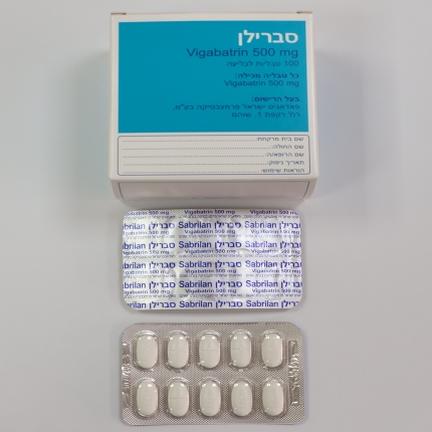Quest for the right Drug

סברילן SABRILAN (VIGABATRIN)
תרופה במרשם
תרופה בסל
נרקוטיקה
ציטוטוקסיקה
צורת מתן:
פומי : PER OS
צורת מינון:
טבליות מצופות פילם : FILM COATED TABLETS
עלון לרופא
מינוניםPosology התוויות
Indications תופעות לוואי
Adverse reactions התוויות נגד
Contraindications אינטראקציות
Interactions מינון יתר
Overdose הריון/הנקה
Pregnancy & Lactation אוכלוסיות מיוחדות
Special populations תכונות פרמקולוגיות
Pharmacological properties מידע רוקחי
Pharmaceutical particulars אזהרת שימוש
Special Warning עלון לרופא
Physicians Leaflet
Pharmacological properties : תכונות פרמקולוגיות
Pharmacodynamic Properties
5.1 Pharmacodynamic properties Pharmacotherapeutic group: Antiepileptics, ATC code: N03AG04 Mechanism of action Vigabatrin is an antiepileptic drug with a clearly defined mechanism of action. Treatment with vigabatrin leads to an increase in the concentration of GABA (gamma aminobutyric acid), the major inhibitory neurotransmitter in the brain. This is because vigabatrin was designed rationally as a selective, irreversible inhibitor of GABA-transaminase, the enzyme responsible for the breakdown of GABA. Clinical efficacy and safety Controlled and long term clinical trials have shown that vigabatrin is an effective anticonvulsant agent when given as add on therapy in patients with epilepsy not controlled satisfactorily by conventional therapy. This efficacy is particularly marked in patients with seizures of partial origin. Epidemiology of VFD in patients with refractory partial epilepsy was examined in an observational, open- label, multicentre, comparative, parallel group, Phase IV study, including 734 patients, at least 8 years old, with refractory partial epilepsy for at least one year. Patients were split in three treatment groups: patients currently treated with vigabatrin (group I), patients previously exposed to vigabatrin (group II) and patients never exposed to vigabatrin (group III). The following table presents the main findings at inclusion and at the first and last conclusive evaluations in the evaluable population (n=524): Children (from aged 8 to 12 years old) Adults (aged > 12 years old) Group I1 Group II2 Group Group I3 Group II4 Group III N = 38 N = 47 III N = 150 N = 151 N = 97 N = 41 Visual field defect with non- identified etiology: -Observed at inclusion 1 (4.4%) 3 (8.8%) 2 (7.1%) 31 (34.1%) 20 (19.2%) 1 (1.4%) -Observed at first 4 (10.5%) 6 (12.8%) 2 (4.9%) 59 (39.3%) 39 (25.8%) 4 (4.1%) conclusive evaluation -Observed at last 10 (26.3%) 7 (14.9%) 3 (7.3%) 70 (46.7%) 47 (31.1%) 5 (5.2%) conclusive evaluation 1 Median treatment duration: 44.4 months; mean daily dose: 1.48 g 2 Median treatment duration: 20.6 months; mean daily dose: 1.39 g 3 Median treatment duration: 48.8 months; mean daily dose: 2.10 g 4 Median treatment duration: 23.0 months; mean daily dose: 2.18 g
Pharmacokinetic Properties
5.2 Pharmacokinetic properties Absorption Vigabatrin is a water soluble compound and it is rapidly and completely absorbed from the gastrointestinal tract. Food administration does not alter the extent of vigabatrin absorption. Time to reach maximum plasma concentrations (tmax) is approximately 1 hour. Distribution Vigabatrin is widely distributed with an apparent volume of distribution slightly greater than total body water. Binding to plasma proteins is negligible. Plasma and cerebrospinal fluid concentrations are linearly related to dose over the recommended dose range. Biotransformation Vigabatrin is not significantly metabolised. No metabolites have been identified in plasma. Elimination Vigabatrin is eliminated via renal excretion with a terminal half-life of 5-8 hours. Oral clearance (Cl/F) of vigabatrin is approximately 7 L/h (i.e. 0.10 L/h.kg). Approximately 70% of a single oral dose was recovered as unchanged drug in the urine in the first 24 hours post-dose. Pharmacokinetic/pharmacodynamic relationships There is no direct correlation between plasma concentration and efficacy. The duration of the effect of the drug is dependent on the GABA-transaminase re-synthesis rate. Paediatric population Pharmacokinetic properties of vigabatrin have been investigated in groups of six neonates (age 15-26 days), six infants (age 5-22 months) and six children (age 4.6-14.2 years) with refractory epilepsy. After administration of a single 37-50 mg/kg dose of an oral solution vigabatrin tmax was approximately 2.5 hours in neonates and infants, and 1 hour in children. Mean terminal half-life of vigabatrin was about 7.5 hours in neonates, 5.7 hours in infants and 5.5 hours in children. The mean Cl/F of active S-enantiomer of vigabatrin in infants and children was 0.591 L/h/kg and 0.446 L/h/kg, respectively.

שימוש לפי פנקס קופ''ח כללית 1994
Epilepsy which is not controlled by other antiepileptic drugs (in combination with other antiepileptic drugs). יירשם ע"י מנהל מחלקה או יחידה נוירולוגית לחולים לא מאוזנים ע"י תרופות אנטיאפילפטיות אחרות
תאריך הכללה מקורי בסל
01/01/1995
הגבלות
תרופה מוגבלת לרישום ע'י רופא מומחה או הגבלה אחרת
רישום
058 94 27254 00
מחיר
0 ₪
מידע נוסף
